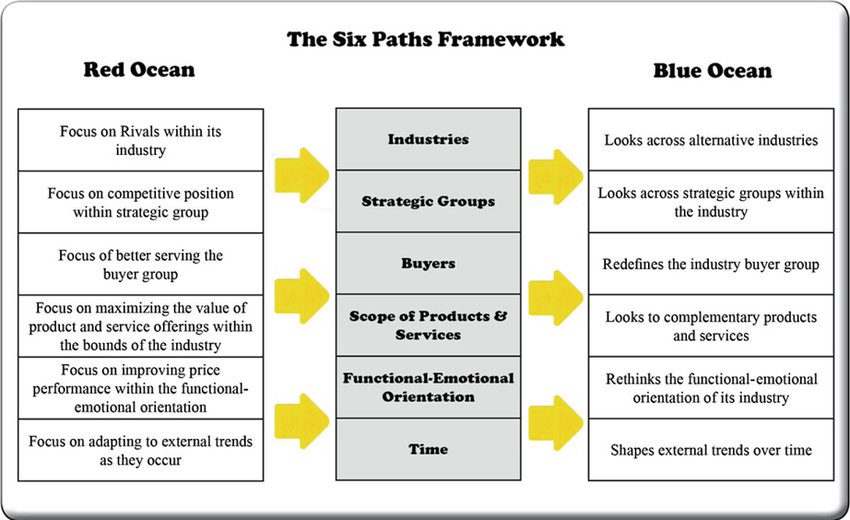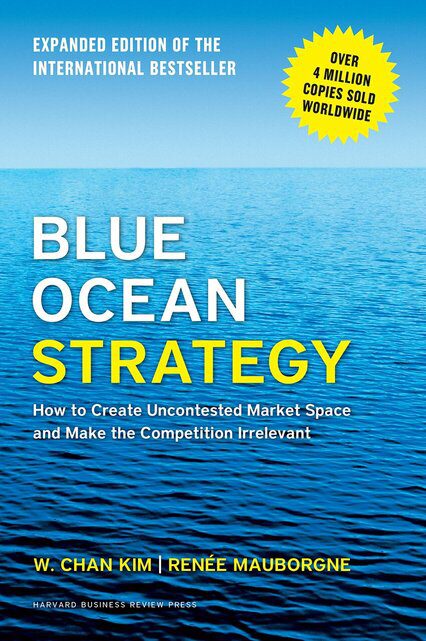Print | Kindle(eBook) | Audiobook
Blue Ocean Strategy is a book published in 2004 written by W. Chan Kim and Renée Mauborgne, professors at INSEAD. Chan Kim and Renée Mauborgne are Professors of Strategy at INSEAD, one of the world’s top business schools, and co-directors of the INSEAD Blue Ocean Strategy Institute in Fontainebleau, France.
The Blue Ocean Strategy is one of the most impactful business book have ever read, my first reading was around 2010, and have since read the book more than 3 times, and it keeps resonating each time. Blue ocean strategy breaks from the stranglehold of competition. At the book’s core is the notion of a shift from competing to creating new market space, making the competition irrelevant.
Blue ocean strategy challenges companies to break out of the red ocean of bloody competition by creating uncontested market space that makes the competition irrelevant. Instead of dividing up existing—and often shrinking—demand and benchmarking competitors, blue ocean strategy is about growing demand and breaking away from the competition.
Here are my favourite take-aways from reading, Blue Ocean Strategy by Chan Kim and Renée Mauborgne:
Competition should not occupy the center of strategic thinking.
Red Ocean vs Blue Ocean Strategy
Red Ocean
- In the red oceans, industry boundaries are defined and accepted, and the competitive rules of the game are known. Here, companies try to outperform their rivals to grab a greater share of existing demand. As the market space gets crowded, prospects for profits and growth are reduced. Products become commodities, and cutthroat competition turns the red ocean bloody.
“To focus on the red ocean is therefore to accept the key constraining factors of war—limited terrain and the need to beat an enemy to succeed—and to deny the distinctive strength of the business world: the capacity to create new market space that is uncontested.”
Blue Oceans
- Blue oceans, in contrast, are defined by untapped market space, demand creation, and the opportunity for highly profitable growth. Although some blue oceans are created well beyond existing industry boundaries, most are created from within red oceans by exp by expanding existing industry boundaries, as Cirque du Soleil did. In blue oceans, competition is irrelevant because the rules of the game are waiting to be set.
“It will always be important to swim successfully in the red ocean by outcompeting rivals. Red oceans will always matter and will always be a fact of business life. But with supply exceeding demand in more industries, competing for a share of contracting markets, while necessary, will not be sufficient to sustain high performance. Companies need to go beyond competing. To seize new profit and growth opportunities, they also need to create blue oceans.”
Value Innovation
- Companies that break away from the competition pay little heed to matching or beating rivals or carving out a favorable competitive position.
- The aim of the Blue Ocean Strategy was not to outperform competitors. It was to offer a quantum leap in value that made the competition irrelevant. The focus on innovating at value, not positioning against competitors, drives companies to challenge all the factors an industry competes on and to not assume that just because the competition is doing something means it is connected to buyer value.
- Value innovation occurs only when companies align innovation with utility, price, and cost positions. If they fail to anchor innovation with value in this way, technology innovators and market pioneers often lay the eggs that other companies hatch.
Value innovation is a new way of thinking about and executing strategy that results in the creation of a blue ocean and a break from the competition
- Value innovation requires companies to orient the whole system toward achieving a leap in value for both buyers and themselves. Absent such an integral approach, innovation will remain divided from the core of strategy.
SWOT analysis vs Blue ocean strategy
- SWOT analysis—where strategy is about matching a company’s strengths and weaknesses to the opportunities and threats present in the existing industry. Here strategy perforce becomes a zero-sum game where one company’s gain is another company’s loss, as firms are bound by existing market space.
- Blue ocean strategy, by contrast, shows how strategy can shape structure in an organization’s favor to create new market space. It is based on the view that market boundaries and industry structure are not given and can be reconstructed by the actions and beliefs of industry players. As industry history shows, new market spaces are being created every day and are fluid with imagination.
Blue ocean strategy is a strategy that joins analytics with the human dimension of organizations. It recognizes and pays respect to the importance of aligning people’s minds and hearts with a new strategy so that at the level of the individual, people embrace it of their own accord and willingly go beyond compulsory execution to voluntary cooperation in carrying it out.
Cirque du Soleil
- Cirque du Soleil did not compete with Ringling Bros. and Barnum & Bailey. Instead it created uncontested new market space that made the competition irrelevant. It appealed to a whole new group of customers: adults and corporate clients prepared to pay a price several times as great as traditional circuses for an unprecedented entertainment experience.
Cirque du Soleil succeeded because it realized that to win in the future, companies must stop competing with each other. The only way to beat the competition is to stop trying to beat the competition.
Structuralist vs Reconstructionist view
- Competition-based red ocean strategy assumes that an industry’s structural conditions are given and that firms are forced to compete within them, an assumption based on what the academics call.
The structuralist view, or Environmental Determinism.
- In contrast, value innovation is based on the view that market boundaries and industry structure are not given and can be reconstructed by the actions and beliefs of industry players. We call this the reconstructionist view.
“In the red ocean, differentiation raises costs because firms compete with the same best-practice rule. Here, the strategic choices for firms are to pursue sue either differentiation or low cost. In the reconstructionist world, however, the strategic aim is to create new best-practice rules by breaking the existing value-cost trade-off and thereby creating a blue ocean.“
Analytical Tools and Frameworks
Strategy Canvas
“Strategy Canvas, an analytic framework that is central to value innovation and the creation of blue oceans.”
- The strategy canvas is both a diagnostic and an action framework for building a compelling blue ocean strategy. It serves two purposes. First, it captures the current state of play in the known market space. This allows you to understand where the competition is currently investing, the factors the industry currently competes on in products, service, and in products, service, and delivery, and what customers receive from the existing competitive offerings on the market.
“To fundamentally shift the strategy canvas of an industry, you must begin by reorienting your strategic focus from competitors to alternatives, and from customers to noncustomers of the industry”
The Four Actions Framework
To break the trade-off between differentiation and low cost and to create a new value curve, there are four key questions to challenge an industry’s strategic logic and business model:
Which of the factors that the industry takes for granted should be eliminated?
- The first question forces you to consider eliminating factors that companies in your industry have long competed on. Often those factors are taken for granted even though they no longer have value or may even detract from value.
Which factors should be reduced well below the industry’s standard?
- The second question forces you to determine whether products or services have been overdesigned in the race to match and beat the competition.
Which factors should be raised well above the industry’s standard?
- The third question pushes you to uncover and eliminate the compromises your industry forces customers to make.
Which factors should be created that the industry has never offered?
- The fourth question helps you to discover entirely new sources of value for buyers and to create new demand and shift the strategic pricing of the industry.
“When you apply the four actions framework to the strategy canvas of your industry, you get a revealing new look at old perceived truths.”
Strategic Contradictions
- These are areas where a company is offering a high level on one competing factor while ignoring others that support that factor. An example is investing heavily in making a company’s website easy to use but failing to correct the site’s slow speed of operation.
- Strategic inconsistencies can also be found between the level of your offering and your price. For example, a petroleum station company found that it offered “less for more”: fewer services than the best competitor at a higher price. No wonder it was losing market share fast.
Six paths Framework
“To break out of red oceans, companies must break out of the accepted boundaries that define how they compete. Instead of looking within these boundaries, managers need to look systematically across them to create blue oceans. They need to look across alternative industries, across strategic groups, across buyer groups, across complementary product and service offerings, across the functional-emotional orientation of an industry, and even across time. This gives companies keen insight into how to reconstruct market realities to open up blue oceans.”

Overcome Key Organizational Hurdles
ONCE A COMPANY HAS DEVELOPED a blue ocean strategy with a profitable business model, it must execute it. The challenge of execution exists, of course, for any strategy. Companies, like individuals, often have a tough time translating thought into action whether in red or blue oceans. But compared with red ocean strategy, blue ocean strategy represents a significant departure from the status quo. It hinges on a shift from convergence to divergence in value curves at lower costs. That raises the execution bar.
Managers face four major hurdles.
- One is cognitive: waking employees up to the need for a strategic shift. Red oceans may not be the paths to future profitable growth, but they feel comfortable to people and may have even served an organization well until now, so why rock the boat?
- The second hurdle is limited resources. The greater the shift in strategy, the greater it is assumed are the resources needed to execute it. But resources were being cut, and not raised, in many of the organizations we studied.
- The third is motivation. How do you motivate key players to move fast and tenaciously to carry out a break from the status quo? That will take years, and managers don’t have that kind of time.
- The final hurdle is politics. As one manager put it, “In our organization, you get shot down before you stand up.
“ When a company’s value curve still has focus, divergence, and a compelling tagline, it should resist the temptation to value-innovate the business again and instead should focus on lengthening, widening, and deepening its rent stream through operational improvements and geographical expansion to achieve maximum economies of scale and market coverage. It should swim as far as possible in the blue ocean, making itself a moving target, distancing itself from early imitators, and discouraging them in the process. The aim here is to dominate the blue ocean over imitators for as long as possible.”
Red Ocean Trap : The belief that blue ocean strategy is a theory of marketing and a niche strategy.
- Blue ocean strategy should also not be confused with a niche strategy. While the field of marketing has placed significant emphasis on finer segmentation to effectively capture niche markets, blue ocean strategy works in the reverse direction.
- It is more about de-segmenting markets by focusing on key commonalities across buyer groups to open up and capture the largest catchment of demand. When practitioners confuse the two, they all too often are driven to look for customer differences for niche markets in the existing industry space rather than the commonalities that cut across buyer groups in search of blue oceans of new demand.
All the best in your quest to get better. Don’t Settle: Live with Passion.



1 Comment
Pingback: 100 Books Reading Challenge 2020 – Lanre Dahunsi